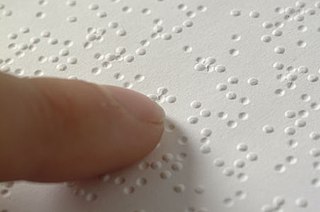The Danish and Norwegian alphabet, called the Dano-Norwegian alphabet is based upon the Latin alphabet and has consisted of the following 29 letters since 1917 (Norwegian) and 1948 (Danish).
Estonian orthography is the system used for writing the Estonian language and is based on the Latin alphabet. The Estonian orthography is generally guided by phonemic principles, with each grapheme corresponding to one phoneme.
Vietnamese Braille is the braille alphabet used for the Vietnamese language. It is very close to French Braille, but with the addition of tone letters. Vietnamese Braille is known in Vietnamese as chữ nổi, literally "raised letters", while electronic braille displays are called màn hình chữ nổi.
Tibetan Braille is the braille alphabet for writing the Tibetan language. It was invented in 1992 by German socialworker Sabriye Tenberken. It is based on German braille, with some extensions from international usage. As in print, the vowel a is not written.

Russian Braille is the braille alphabet of the Russian language. With suitable extensions, it is used for languages of neighboring countries that are written in Cyrillic in print, such as Ukrainian and Mongolian. It is based on the Latin transliteration of Cyrillic, with additional letters assigned idiosyncratically. In Russian, it is known as Шрифт Брайля Shrift Braylya 'Braille Script'.
The goal of braille uniformity is to unify the braille alphabets of the world as much as possible, so that literacy in one braille alphabet readily transfers to another. Unification was first achieved by a convention of the International Congress on Work for the Blind in 1878, where it was decided to replace the mutually incompatible national conventions of the time with the French values of the basic Latin alphabet, both for languages which use Latin-based alphabets and, through their Latin equivalents, for languages which use other scripts. However, the unification did not address letters beyond these 26, leaving French and German Braille partially incompatible, and as braille spread to new languages with new needs, national conventions again became disparate. A second round of unification was undertaken under the auspices of UNESCO in 1951, setting the foundation for international braille usage today.

The braille alphabet used to write Hungarian is based on the international norm for the 26 basic letters of the Latin script. However, the letters for q and z have been replaced, to increase the symmetry of the accented letters of the Hungarian alphabet, which are largely innovative to Hungarian braille.

Czech Braille is the braille alphabet of the Czech language. Like braille in other Latin-script languages, Czech Braille assigns the 25 basic Latin letters the same as Louis Braille's original assignments for French.
Scandinavian Braille is a braille alphabet used, with differences in orthography and punctuation, for the languages of the mainland Nordic countries: Danish, Norwegian, Swedish, and Finnish. In a generally reduced form it is used for Greenlandic.
Polish Braille is a braille alphabet for writing the Polish language. It is based on international braille conventions, with the following extensions:
According to Unesco (2013), there are different braille alphabets for Urdu in India and in Pakistan. The Indian alphabet is based on national Bharati Braille, while the Pakistani alphabet is based on Persian Braille.
Irish Braille is the braille alphabet of the Irish language. It is augmented by specifically Irish letters for vowels that take acute accents in print:
Ukrainian Braille is the braille alphabet of the Ukrainian language. It is based on Russian Braille, with a few additional letters found in the print Ukrainian alphabet.

Spanish Braille is the braille alphabet of Spanish and Galician. It is very close to French Braille, with the addition of a letter for ñ, slight modification of the accented letters, and some differences in punctuation. Further conventions have been unified by the Latin American Blind Union, but differences with Spain remain.
Several braille alphabets are used in South Africa. For English, Unified English Braille has been adopted. Nine other languages have been written in braille: Afrikaans, Ndebele, Sesotho, Northern Sotho, Swazi, Tswana, Venda, Xhosa, and Zulu. All print alphabets are restricted to the basic Latin alphabet, with diacritics in some cases; the braille alphabets are likewise basic braille with additional letters to render the diacritics.
Faroese Braille is the braille alphabet of the Faroese language. It has the same letter assignments as the rest of the Nordic braille alphabets.
Northern Sami Braille is the braille alphabet of the Northern Sami language.
Belarusian Braille is the braille alphabet of the Belarusian language. It is based on Russian Braille, with a couple additional letters found in the print Belarusian alphabet.





